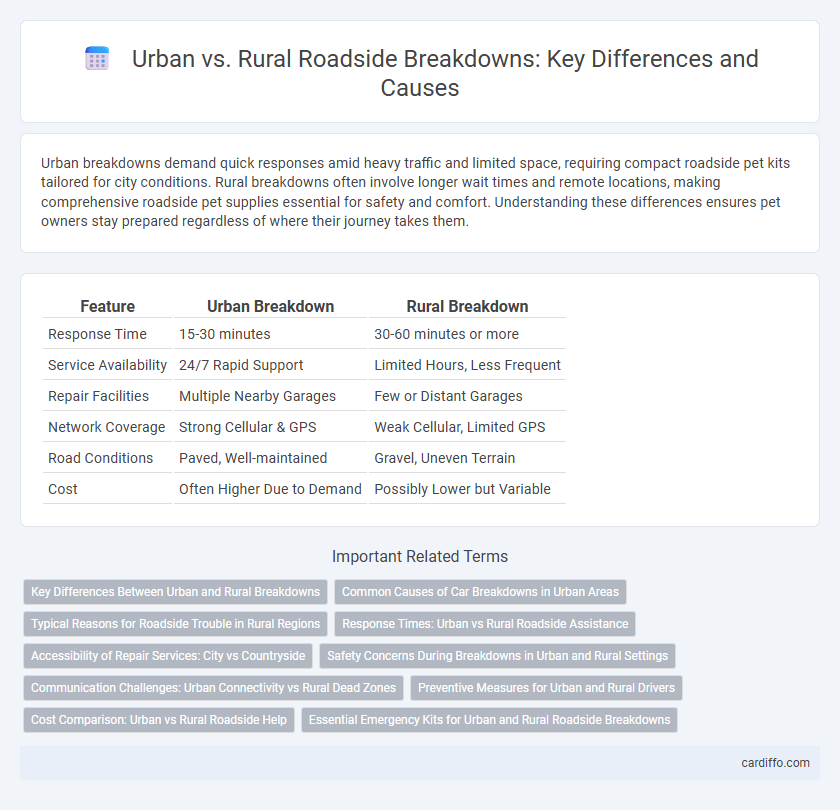Urban breakdowns demand quick responses amid heavy traffic and limited space, requiring compact roadside pet kits tailored for city conditions. Rural breakdowns often involve longer wait times and remote locations, making comprehensive roadside pet supplies essential for safety and comfort. Understanding these differences ensures pet owners stay prepared regardless of where their journey takes them.
Table of Comparison
| Feature | Urban Breakdown | Rural Breakdown |
|---|---|---|
| Response Time | 15-30 minutes | 30-60 minutes or more |
| Service Availability | 24/7 Rapid Support | Limited Hours, Less Frequent |
| Repair Facilities | Multiple Nearby Garages | Few or Distant Garages |
| Network Coverage | Strong Cellular & GPS | Weak Cellular, Limited GPS |
| Road Conditions | Paved, Well-maintained | Gravel, Uneven Terrain |
| Cost | Often Higher Due to Demand | Possibly Lower but Variable |
Key Differences Between Urban and Rural Breakdowns
Urban breakdowns often involve complex traffic congestion and limited space for emergency vehicle access, whereas rural breakdowns typically face challenges with longer response times and limited cell service coverage. Urban areas have higher vehicle density and a greater likelihood of minor collisions or mechanical failures due to stop-and-go traffic, while rural breakdowns may involve more severe vehicle damage from higher-speed incidents or rough terrain. Emergency roadside assistance in urban settings generally benefits from shorter travel distances, contrasting with rural areas where assistance providers must cover extensive areas, affecting overall recovery times.
Common Causes of Car Breakdowns in Urban Areas
In urban areas, common causes of car breakdowns include battery failure due to frequent short trips, overheating from heavy stop-and-go traffic, and tire damage caused by potholes and congested streets. Electrical system issues are prevalent due to constant use of urban accessories like air conditioning and infotainment systems. Urban breakdowns often result from higher vehicle wear in dense traffic compared to rural breakdowns, which are frequently linked to long-distance travel and less vehicle stress.
Typical Reasons for Roadside Trouble in Rural Regions
Rural breakdowns often stem from vehicle issues related to rough terrain and longer travel distances between service centers. Common causes include flat tires from uneven roads, battery failures due to infrequent trips, and overheating linked to heavy loads or improper engine maintenance. Limited mobile coverage and scarce roadside assistance options further complicate timely repairs in rural areas.
Response Times: Urban vs Rural Roadside Assistance
Response times for roadside assistance significantly vary between urban and rural areas, with urban breakdowns typically receiving faster service due to higher proximity of service providers and denser infrastructure. In rural locations, longer distances and limited availability of technicians extend waiting periods, often doubling the response time compared to city environments. Efficient dispatch systems and strategic placement of emergency units contribute to minimizing delays in urban roadside assistance scenarios.
Accessibility of Repair Services: City vs Countryside
Urban breakdowns benefit from immediate access to numerous repair services and parts suppliers, minimizing downtime for stranded motorists. In contrast, rural breakdowns often face limited repair facilities and longer response times, increasing inconvenience and potential hazards for drivers. The disparity in accessibility highlights the critical need for enhanced roadside assistance infrastructure in countryside areas.
Safety Concerns During Breakdowns in Urban and Rural Settings
Urban breakdowns often pose heightened safety risks due to heavy traffic, limited space for emergency stops, and increased likelihood of pedestrian accidents. In contrast, rural breakdowns present dangers from slower emergency response times, poor lighting, and exposure to wildlife or extreme weather conditions. Both settings require distinct safety measures, including reflective warning devices and timely communication with roadside assistance.
Communication Challenges: Urban Connectivity vs Rural Dead Zones
Urban breakdowns benefit from dense cellular networks enabling rapid communication with roadside assistance, while rural breakdowns face significant challenges due to limited network coverage and frequent dead zones. The availability of 4G and 5G infrastructure in cities supports real-time tracking and emergency alerts, in contrast to rural areas where signal loss often delays help and compromises driver safety. Efficient roadside support in rural settings requires investment in signal boosters, satellite communication, and localized emergency systems to overcome connectivity gaps.
Preventive Measures for Urban and Rural Drivers
Urban drivers benefit from advanced roadside assistance services and frequent vehicle inspections, reducing breakdown risks through routine maintenance such as oil changes and tire checks. Rural drivers need tailored preventive measures including carrying emergency kits, ensuring proper tire tread for unpaved roads, and scheduling regular engine diagnostics to handle longer response times. Both settings emphasize the importance of proactive vehicle care to minimize breakdown frequency and enhance driver safety.
Cost Comparison: Urban vs Rural Roadside Help
Urban roadside assistance typically incurs higher costs due to increased labor rates, traffic congestion, and demand for faster service times compared to rural areas. In contrast, rural breakdown help often involves longer travel distances for technicians, which can increase service fees despite lower labor rates. Analyzing cost drivers reveals that urban roadside help prioritizes speed and accessibility, while rural service fees reflect logistical challenges and less frequent service availability.
Essential Emergency Kits for Urban and Rural Roadside Breakdowns
Urban roadside breakdowns often require compact essential emergency kits equipped with items like portable jump starters, compact tire inflators, and multi-functional tools to navigate congested city environments. Rural breakdown kits emphasize comprehensive supplies, including larger fuel cans, detailed first aid kits, robust flares, and emergency blankets to address longer wait times and limited service access. Tailoring emergency kits to urban or rural contexts enhances roadside safety and ensures preparedness for specific environmental challenges.
Urban breakdown vs rural breakdown Infographic

 cardiffo.com
cardiffo.com